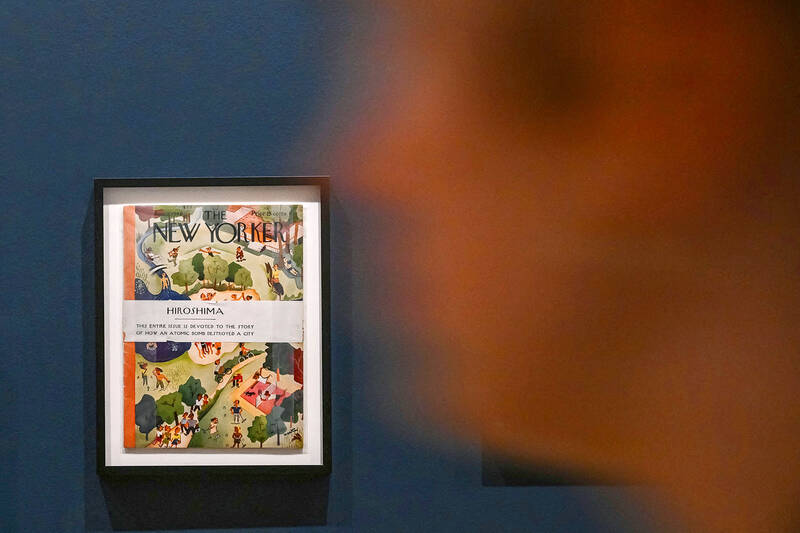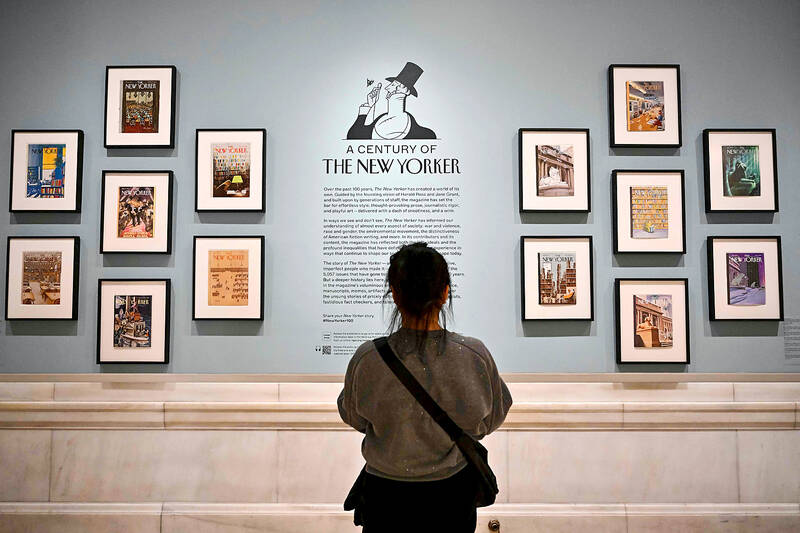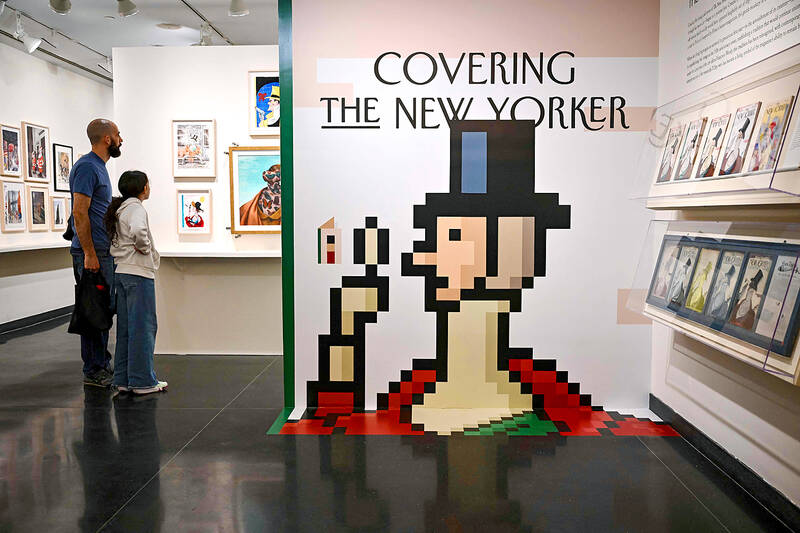The New Yorker magazine, a staple of American literary and cultural life defined by its distinctive covers, long-form journalism, witty cartoons and particular grammar, is celebrating 100 years on newsstands.
To mark the publication’s centenary milestone, four commemorative issues are being released, while its namesake city will host seven exhibitions ahead of a Netflix documentary on the title known for its artistic cover creations.
Despite its storied history, the New Yorker often puts a mirror up to current events. Three founding fathers were shown on a recent cover design being marched out of office, carrying their effects in cardboard boxes in a satirical commentary on US President Donald Trump’s assault on the status quo.

Photo: AFP
Francoise Mouly, the magazine’s artistic director, said the New Yorker was not immune from the crisis plaguing the media.
“But I’m stubborn and I see the future with a lot of confidence and hope,” she said.
Mouly has been one of the conductors of the New Yorker orchestra since 1993, selecting the cover that week after week lends the magazine its unique identity.

Photo: AFP
“There are some printed products that will never be replaced by digital — children’s books, comics and the New Yorker,” she said at a recent exhibition showcasing the magazine’s art, held at New York’s Alliance Francaise cultural center.
One example of cover art on display depicts a rush-hour subway scene in which all the passengers are animals, while another by Mouly’s husband Art Spiegelman shows a Black woman kissing a Hasidic man.
That 1993 design, which followed clashes between the two communities in a Brooklyn neighborhood, stirred controversy at the time and remains one of the title’s most discussed covers.

Photo: AFP
With more than 5,000 editions over the past century, the magazine has published literary greats like Truman Capote’s 1965 In Cold Blood, while also giving James Baldwin space to write about race relations.
‘INCREDIBLY SUCCESSFUL’
Ernest Hemingway, Susan Sontag and JD Salinger are among the authors to have graced the pages of the magazine which combines current affairs, analysis, fiction, reviews, criticism, poetry and of course its legendary cartoons.
Published weekly, the magazine has reported global scoops like the fullest account of the US atomic bomb dropped on Hiroshima, with the entirety of the Aug. 31, 1946 edition given over to John Hersey’s article.
In 1961 Hannah Arendt covered the trial of Nazi war criminal Adolf Eichmann in the reporting of which she coined the phrase “the banality of evil.”
In recent years the magazine won a Pulitzer Prize for Ronan Farrow’s reporting of predatory film mogul Harvey Weinstein, fuelling the “MeToo” movement.
“These were all remarkable, long-form stories that really changed the course of American history, not just American journalism,” said Julie Golia, curator of an exhibition on the magazine at The New York Public Library.
Founded on February 21, 1925, the New Yorker did not always have such lofty ambitions.
At the height of the Jazz Age, amid post-war and pre-depression euphoria, husband and wife founders Harold Ross and Jane Grant set out to create “a magazine of wit and cosmopolitanism, an urbane magazine, but not one that took itself too seriously.”
One hundred years on, it boasts 1.3 million subscribers, most of whom subscribe in both print and digital formats. It is a jewel in the crown of media group Conde Nast, which also publishes Vogue, Vanity Fair and GQ, having bought the New Yorker in 1985.
Despite its highbrow image, the magazine has adapted to the digital age emphasizing subscriptions over advertising, editor-in-chief since 1998 David Remnick said in a recent radio interview.
“The New Yorker is much more than those pages that people get in the mail,” said Golia.
“It’s a Web site, it’s podcasts, it’s a festival and it’s a brand (and) as a brand, it’s incredibly successful.”

April 14 to April 20 In March 1947, Sising Katadrepan urged the government to drop the “high mountain people” (高山族) designation for Indigenous Taiwanese and refer to them as “Taiwan people” (台灣族). He considered the term derogatory, arguing that it made them sound like animals. The Taiwan Provincial Government agreed to stop using the term, stating that Indigenous Taiwanese suffered all sorts of discrimination and oppression under the Japanese and were forced to live in the mountains as outsiders to society. Now, under the new regime, they would be seen as equals, thus they should be henceforth

Last week, the the National Immigration Agency (NIA) told the legislature that more than 10,000 naturalized Taiwanese citizens from the People’s Republic of China (PRC) risked having their citizenship revoked if they failed to provide proof that they had renounced their Chinese household registration within the next three months. Renunciation is required under the Act Governing Relations Between the People of the Taiwan Area and the Mainland Area (臺灣地區與大陸地區人民關係條例), as amended in 2004, though it was only a legal requirement after 2000. Prior to that, it had been only an administrative requirement since the Nationality Act (國籍法) was established in

With over 80 works on display, this is Louise Bourgeois’ first solo show in Taiwan. Visitors are invited to traverse her world of love and hate, vengeance and acceptance, trauma and reconciliation. Dominating the entrance, the nine-foot-tall Crouching Spider (2003) greets visitors. The creature looms behind the glass facade, symbolic protector and gatekeeper to the intimate journey ahead. Bourgeois, best known for her giant spider sculptures, is one of the most influential artist of the twentieth century. Blending vulnerability and defiance through themes of sexuality, trauma and identity, her work reshaped the landscape of contemporary art with fearless honesty. “People are influenced by

The remains of this Japanese-era trail designed to protect the camphor industry make for a scenic day-hike, a fascinating overnight hike or a challenging multi-day adventure Maolin District (茂林) in Kaohsiung is well known for beautiful roadside scenery, waterfalls, the annual butterfly migration and indigenous culture. A lesser known but worthwhile destination here lies along the very top of the valley: the Liugui Security Path (六龜警備道). This relic of the Japanese era once isolated the Maolin valley from the outside world but now serves to draw tourists in. The path originally ran for about 50km, but not all of this trail is still easily walkable. The nicest section for a simple day hike is the heavily trafficked southern section above Maolin and Wanshan (萬山) villages. Remains of